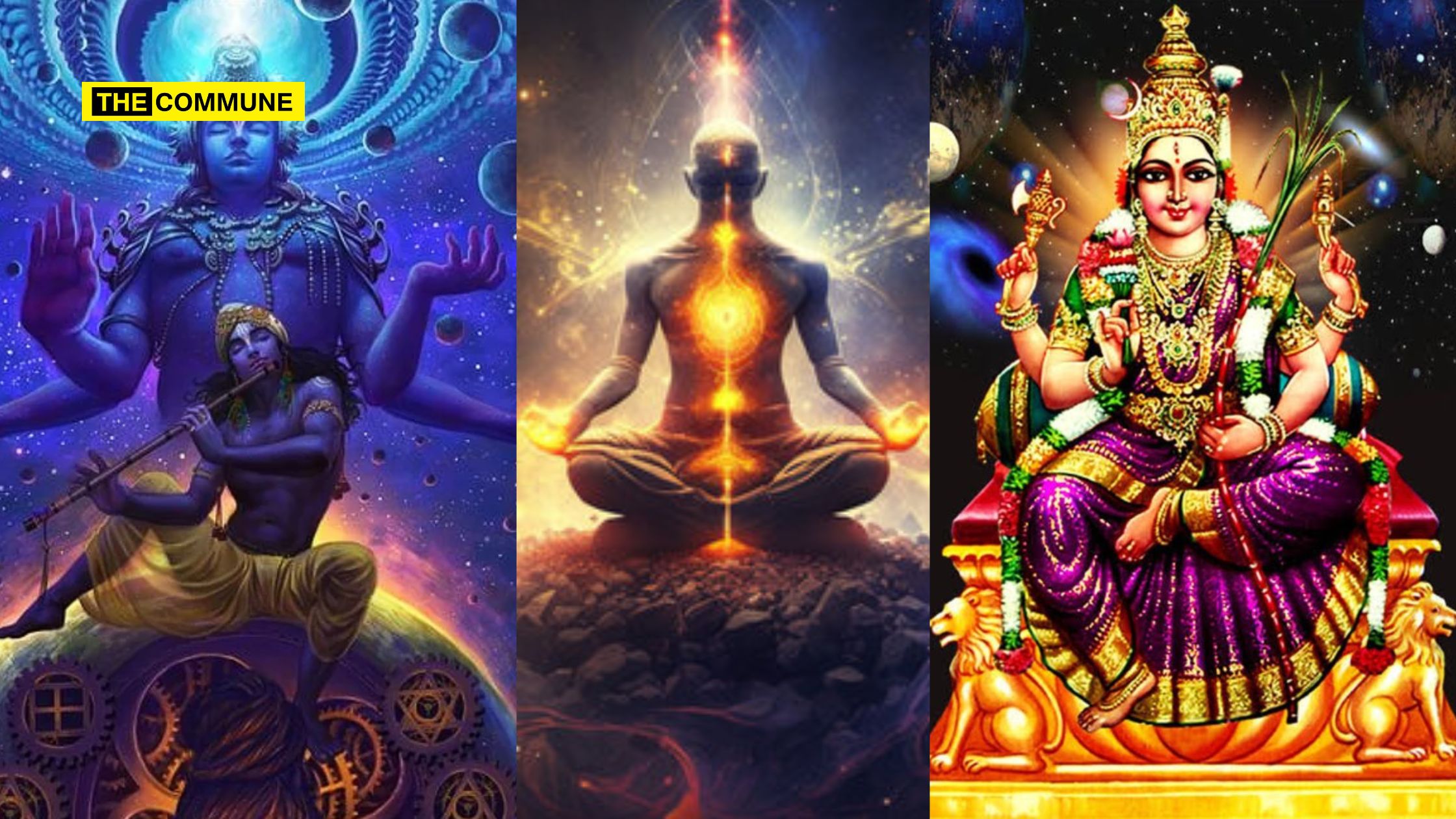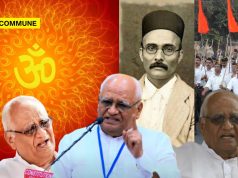

The term “Varna” itself translates to ‘color’. References to Varna appear in ancient texts such as the Rig Veda (10.90.12), Atharva Veda (19.62), as well as in various Brahmanas including the Satapata Brahmana. Additionally, the Bhagavad Gita features mentions of Varna in several places, including Chapter 4, Verse 13 and Chapter 18, Verse 41. Furthermore, Varna is referenced in the Lalitha Sahasarnamam, a well-known Sanskrit hymn from the Brahmanda Purana.
The focus here is on the Bhagavad Gita and Lalitha Sahasranamam because these verses are indicative of Kundalini Yoga.
Glimpses From Gita
Gita Verse 4:13
चातुर्वर्ण्यं मया सृष्टं गुणकर्मविभागश: |
तस्य कर्तारमपि मां विद्ध्यकर्तारमव्ययम् || 13||
chātur-varṇyaṁ mayā sṛiṣhṭaṁ guṇa-karma-vibhāgaśhaḥ
tasya kartāram api māṁ viddhyakartāram avyayam
Meaning:
“The four categories of Varna were created by Me according to people’s qualities and activities. Although I am the Creator of this system, know Me to be the Non-doer and Eternal.”
Commentary:
The Vedic philosophy offers a structured explanation for this diversity, viewing material energy as comprised of three fundamental qualities known as “guṇas”: sattva guṇa (mode of goodness), rajo guṇa (mode of passion), and tamo guṇa (mode of ignorance). In this framework, individuals are categorized based on their predominant qualities and actions: Shudra embodies ignorance, Vaishyas exhibit passion mixed with ignorance, Kshatriyas demonstrate passion mixed with Godliness, and Brahmanas represent pure Godliness.
The classification within the Varṇāśhram system aligns with people’s inherent qualities and behaviors.
While God is acknowledged as the creator of the world’s structure, the philosophy also emphasizes the concept of non-doership. This analogy likens God’s role to that of rain, which falls uniformly but leads to varied outcomes depending on the seeds it nourishes. Similarly, while God endows souls with the energy to act, individuals possess free will in determining their actions, with God not being held accountable for their choices.
Gita Verse 18:41
ब्राह्मणक्षत्रियविशां शूद्राणां च परन्तप |
कर्माणि प्रविभक्तानि स्वभावप्रभवैर्गुणै: || 41||
brāhmaṇa-kṣhatriya-viśhāṁ śhūdrāṇāṁ cha parantapa
karmāṇi pravibhaktāni svabhāva-prabhavair guṇaiḥ
Meaning:
“The duties of the Brahmana, Kshatriya, Vaishya, and Shudra—are distributed according to their qualities, in accordance with their guṇas (and not by birth).”
Commentary:
In this context, Lord Krishna elucidates that individuals possess diverse inherent natures, shaped by the fundamental qualities known as “guṇas” that comprise their personalities. Accordingly, different professional roles are suited to these varied dispositions.
Within the varṇa system, there existed no inherent hierarchy among the categories. With God at the core of society, individuals engaged in occupations aligned with their intrinsic qualities, contributing to the sustenance of both themselves and the community. Success was measured by one’s progress towards realizing God, fostering a sense of unity amid diversity. Diversity, akin to the multifunctionality of limbs in the body, was regarded as natural and indispensable.
Over time, however, the varṇa system underwent deterioration, shifting from a nature-based classification to one based on birth. Brahmin children began identifying as Brahmins irrespective of their inherent qualities, perpetuating the emergence of hierarchical notions and the marginalization of lower castes. As the system became rigid and birth-oriented, it lost functionality, deviating from its original purpose. This social distortion was a consequence of temporal influences and strayed from the intended essence of the varṇa system.
Gita Verse: 13.2
इदं शरीरं कौन्तेय क्षेत्रमित्यभिधीयते |
एतद्यो वेत्ति तं प्राहु: क्षेत्रज्ञ इति तद्विद: || 2||
śhrī-bhagavān uvācha
idaṁ śharīraṁ kaunteya kṣhetram ity abhidhīyate
etad yo vetti taṁ prāhuḥ kṣhetra-jña iti tad-vidaḥ
Meaning:
“O Arjun, this body is termed as kṣhetra (the field of activities), and the one who knows this body is called kṣhetrajña (the knower of the field) by the sages who discern the truth about both.”

Commentary:
In Bhagavad Gita 13.2, Lord Krishna compares the body to a “kṣhetra” or field of activities, while the conscious self is termed “kṣhetrajña,” the knower of the field. This analogy highlights the transient nature of the body and the eternal essence of the self. Understanding oneself as the observer of the body fosters detachment from worldly affairs and cultivates a deeper connection with the eternal soul. Lord Krishna emphasizes the wisdom of sages who discern the truth about the body and the self, guiding seekers toward self-realization. This verse underscores the importance of self-awareness and spiritual insight in transcending the limitations of the material world and realizing one’s true nature.
Gita Verse 4.29-30
अपाने जुह्वति प्राणं प्राणेऽपानं तथापरे |
प्राणापानगती रुद्ध्वा प्राणायामपरायणा: || 29||
अपरे नियताहारा: प्राणान्प्राणेषु जुह्वति |
सर्वेऽप्येते यज्ञविदो यज्ञक्षपितकल्मषा: || 30||
apāne juhvati prāṇaṁ prāṇe ’pānaṁ tathāpare
prāṇāpāna-gatī ruddhvā prāṇāyāma-parāyaṇāḥ
apare niyatāhārāḥ prāṇān prāṇeṣhu juhvati
sarve ’pyete yajña-vido yajña-kṣhapita-kalmaṣhāḥ
Meaning:
“Still others offer as sacrifice the outgoing breath in the incoming breath, while some offer the incoming breath into the outgoing breath. Some arduously practice prāṇāyām and restrain the incoming and outgoing breaths, purely absorbed in the regulation of the life-energy. Yet others curtail their food intake and offer the breath into the life-energy as sacrifice. All these knowers of sacrifice are cleansed of their impurities as a result of such performances.”
Commentary:
Some individuals are attracted to the practice of prāṇāyām, which involves various techniques for controlling the breath. These techniques include Pūrak, the inhalation process, Rechak, exhalation, Antar kumbhak, holding the breath after inhalation, and Bāhya kumbhak, holding the breath after exhalation. These practices require guidance from qualified teachers to prevent potential harm. Yogis who engage in prāṇāyām aim to regulate their senses and concentrate their minds. They offer their disciplined minds as a spiritual sacrifice, known as yajña, to the Supreme Being.
Glimpses from Lalitha Sahasranamam
- आब्रह्मकीटजननी – AabrahmaKeeta Janani: She is the mother of everything from Brahma to the tiniest insect.
- वर्णाश्रमविधायिनि – Varnashrama Vidhayini: She established the Varnashramam.
- निजाज्ञारूपनिगमा – Her commands take the form of the Vedas.
In Lalitha Sahasranamam, the presence of the term “Varnashrama” might surprise you. This hymn praises Devi Shakthi in 1000 verses, representing the awakened Kundalini Shakti within all beings.
- मूलाधारैकनिलया – Mooladharaikani Layaa: She dwells in the Muladhara chakra.
- ब्रह्मग्रन्थिविभेदिनी – Brahmagranthivibhedini: She unravels the knot of Brahma.
- मणिपूरान्तरुदिता – Manipurantaruditaa: She emerges in the Manipura chakra.
- विष्णुग्रन्थिविभेदिनी – Vishnugranthivibhedini: She unties the knot of Vishnu.
- आज्ञाचक्रान्तरालस्था – Ajnachakrantarastha: She resides at the center of the Ajna chakra.
- रुद्रग्रन्थिविभेदिनी – Rudragranthivibhedini: She releases the knot of Shiva.
- सहस्राराम्बुजारूढा – Sahasrararudha: She ascends to the thousand-petaled lotus.
- सुधासाराभिवर्षिणी – Sudhasarabhi Varshini: She showers streams of ambrosia.
- तडिल्लतासमरुचिः – Tadillatasamaruchih: She shines like a flash of lightning.
- षट्चक्रोपरिसंस्थिता – Shatchakroparisamsthita: She sits above the six chakras.
- महासक्तिः – Mahasaktih: She is deeply attached to the divine union of Shiva and Shakti.
- कुण्डलिनी – Kundalini: She manifests in the form of a coil.
These terms, such as Mooladhara, Manipura, and Ajna chakras, and Brahma Granthi, Vishnu Granthi, Rudra Granthi, are integral to Kundalini techniques.


Why do these texts discussing Kundalini techniques emphasize the term ‘Varna’?
Varna does not refer to a caste-based hierarchy.
When a person’s life revolves around basic needs like food and sex, their energy is dormant. Overcoming these needs activates the ‘Mooladhara’ chakra, identifying the person as a ‘SHUDRA’. When the person develops a strong heart and universal love, overcoming all forms of fear, the ‘Anahattha’ chakra is activated, making them a ‘KSHATRIYA’. When the person transcends individuality and realizes pure consciousness, the ‘Sahasrara’ chakra is activated, making them ‘BRAHMANA/BRAHMAN’. The term ‘Brahmin’ is a corrupted version of the original word ‘BRAHMAN’. Anyone who comprehends Brahma Vidya (Knowledge of Brahman) is called a Brahman.
These distinctions of Varnas originally signified spiritual progress, but over thousands of years, they were corrupted by some unenlightened Indian rulers and further misinterpreted by foreign invaders (Mughals and British).
Misinterpreting Varna as caste, hierarchy, or discrimination stems from a lack of understanding of the metaphors and allegories used in the Vedas, Upanishads, and other spiritual texts.



Varna can be understood by correlating it with the Maslow’s hierarchy of needs, a motivational theory in psychology proposed by Abraham Maslow in 1943.
Glimpses From Mundaka Upanishad
स यो ह वै तत् परमं ब्रह्म वेद ब्रह्मैव भवति नास्याब्रह्मवित्कुले भवति । तरति शोकं तरति पाप्मानं गुहाग्रन्थिभ्यो विमुक्तोऽमृतो भवति ॥९॥”
III-ii-9: Whoever knows the supreme Brahman becomes Brahman themselves. In their lineage, no one ignorant of Brahman is born. They transcend grief and sins; freed from the knots of the heart, they attain immortality.
Sri Skanda Purana Vol.18 Book VI, Nagar Kanda, Chapter 239
जन्मना जायते शूद्रः संस्कारात् द्विज उच्यते। वेदाभ्यास भवति विप्र ब्रह्मम जानति ब्राह्मणः||
A person is born a Shudra, but becomes a Brahman through rituals and penance. By studying the Vedas, they gain wisdom, and by knowing Brahman, they become Brahman.
This means that everyone is born a Shudra but can achieve enlightenment through purification, enrichment, and education.
“Dwija” means “twice-born” and typically refers to a Brahman.
“A Shudra is someone without knowledge, and this term should not be linked to any caste.”
For example, Ratnakara, a dacoit and ignorant Shudra, became a Brahman and composed the Ramayana through Brahma Vidya (knowledge of Brahman).
Dark Knight is a writer trying to bring out metaphors, allegories and the hidden essence of Sanatana Dharma.
References:
- https://www.holy-bhagavad-gita.org/chapter/4/verse/13
- https://www.holy-bhagavad-gita.org/chapter/18/verse/41
- https://www.holy-bhagavad-gita.org/chapter/13/verse/2
- https://www.holy-bhagavad-gita.org/chapter/4/verse/29-30
- https://hinduism.stackexchange.com/questions/54610/where-is-the-shloka-bramha-janati-iti-brahmanaha-found
- https://sanskritdocuments.org/doc_devii/lalita1000.html
- https://www.indica.today/long-reads/varna-vyavastha-as-a-conceptual-social-order-that-facilitates-self-actualization/
- https://www.telegraphindia.com/india/banaras-hindu-university-researches-manusmriti-applicability/cid/1919602




